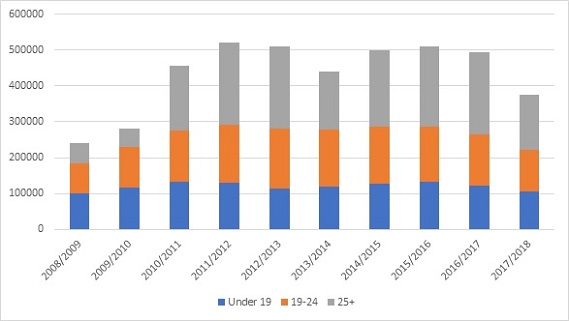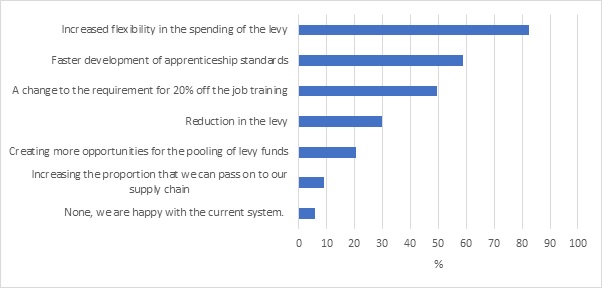Yesterday we released a major new piece of research looking at employers perspectives on the apprenticeship system. In this blog the ISE’s Chief Research Officer, Tristram Hooley explains what is right and wrong with the current system and sets out the 10 things that employers believe that the government should do to fix apprenticeships. We would like people to support our campaign to #fixapprenticeships by sharing the report and our recommendations as widely as possible.
In 2015 George Osborne, the then Chancellor of the Exchequer, announced a new set of reforms to England’s apprenticeship system. Key to the new reforms was the decision to introduce an apprenticeship levy on employers. But, Osborne promised this wasn’t just a new tax, it was designed to incentivise employers to engage with apprenticeships. This would solve the problem of free riding where some employers scrimped on training and then poached others’ staff. Good employers who were committed to training and development would ‘get out more than they put in’.
Is the apprenticeship system working?
Politicians draft policies in the comfort of Westminster, but the real work of turning the apprenticeship reforms into a reality has been going on in businesses across the country. After 2017 ISE members enthusiastically engaged with the levy, with over three quarters of them now offering apprenticeship programmes.
Our research shows that the process of implementing the new system has not been straightforward. It requires employers to invest heavily and manage a lot of complexity. Building a successful apprenticeship programme within your firm is a long journey.
Despite serious engagement from employers, the apprenticeship system hasn’t achieved the scale that the government were hoping for. Most ISE members report that they are still unable to spend all of their apprenticeship. And overall apprentice numbers have been disappointingly flat, meaning that the government looks set to miss its target of engaging 3 million apprentices by 2020.
Apprenticeship numbers 2008-2018

Evaluating the system
Despite the problems with the system, ISE members are generally supportive of the aims of the current reforms. They believe that the British workforce needs more skills and that they education system should be better aligned to the labour market. They report that apprenticeships are good for the individual, for their businesses and for the economy. In the words of employers themselves…
Apprentices are enthusiastic and capable. The calibre is great. Their energy and their fearlessness is amazing. These people are the future of our organisation.
Because employers see value in the current system they would like to see it maintained and developed into the future. Employers want to see stability in the system rather than radical changes.
As a general rule, we think there are too many changes happening too frequently which creates great uncertainty and instability, deterring employers from investing in programmes.
But, they also report a lot of issues with the current system and identify areas where it could be improved.
Employers told us that:
- the system is too bureaucratic;
- they had problems with the way in which the funding was structured;
- they faced challenges in actually delivering apprenticeship programmes in the way required by policy makers; and
- they had concerns about the perception of apprenticeships by young people, their parents, schools and the general public.
The philosophy of the current system is right, but it is too bureaucratic and expensive for employers to participate in. Our firm is committed to making the system work, but others will find it more difficult.We need to re-invest in schools’ careers advice – as despite the measures taken to date, this is still not moving on quickly enough. There is also a need to better join education policy and apprenticeship policy as while schools are still being measured against the number of young people they get into university it is difficult to get them to focus on apprenticeships. Parents and teachers also need to be educated around all the routes available.
Employers also had lots of ideas about how to solve the problems in the apprenticeship system. They wanted to see more:
- stability;
- transparency;
- flexibility; and
- employer ownership.
We would like more freedom to spend our levy more freely. For example, to use some of it to train the staff who are mentoring apprentices.
I would like to see more transparency in how the levy is spent? Where does it all go?
How employers would like to see the apprenticeship levy reformed

The ISE’s 10 recommendations to fix the apprenticeship system.
- Ensure stability in the apprenticeship system.
- The levy should not be a payroll tax.
- Double the levy ‘expiry date’.
- Increase levy flexibility.
- Join-up the apprenticeship systems in different UK nations.
- Support higher and degree level apprenticeships.
- Review the way apprenticeship standards are created and developed.
- Increase the flexibility in off the job training.
- Celebrate how apprenticeships can transform careers for everyone.
- Promote apprenticeships across the education system.
If you want to support our campaign to #fixapprenticeships then download our campaign pack.


0 Comments